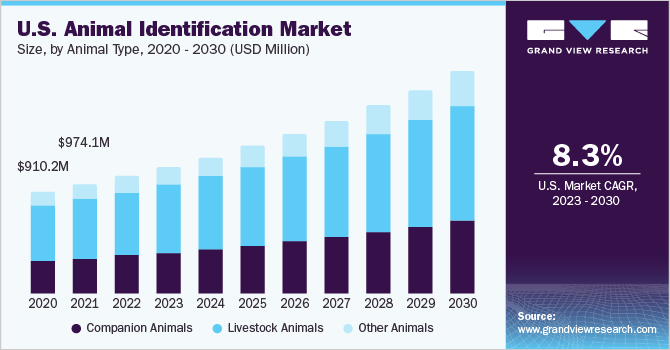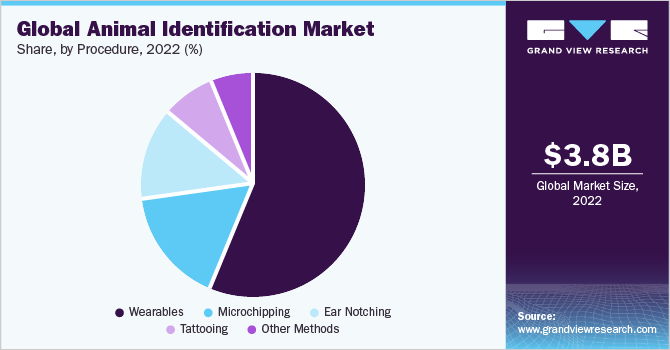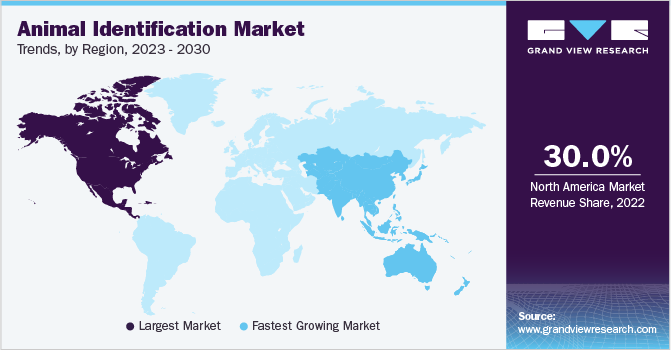- Home
- »
- Animal Health
- »
-
Animal Identification Market Size, Share, Growth Report 2030GVR Report cover
![Animal Identification Market Size, Share & Trends Report]()
Animal Identification Market Size, Share & Trends Analysis Report By Usage (Permanent, Non-permanent), By Solution (Hardware, Services), By Procedure (Wearables, Tattooing), By Animal Type, And Segment Forecasts, 2023 - 2030
- Report ID: GVR-4-68040-085-9
- Number of Report Pages: 150
- Format: PDF, Horizon Databook
- Historical Range: 2018 - 2021
- Forecast Period: 2023 - 2030
- Industry: Healthcare
Animal Identification Market Size & Trends
The global animal identification market size was estimated at USD 3.83 billion in 2022 and is expected to grow at a compound annual growth rate (CAGR) of 9.50% from 2023 to 2030. Key growth drivers include increasing usage of livestock animal tag/ID systems to enhance animal health surveillance & disease eradication measures, easy tracking of animal mortality rate, vaccination status, import & export regulations, and production rates, among others. Rapid identification of disease outbreaks and regional compartmentalization can limit the spread of disease and minimizes the respective economic impacts. In addition, technological advancements in animal healthcare have enabled farmers and other animal owners to use real-time tracking systems that simplify the monitoring processes with early emergency detection.

The global outbreak of COVID-19 infection, especially in the year 2020, brought unprecedented changes in the animal healthcare industry, with extensive nationwide or statewide lockdown measures and supply chain disruptions. One of the key market players, Allflex (Merck Animal Health), stated that the pandemic has affected animal identification tag sales, similar to several other industries owing to port congestion, logistics & freight delays, and quarantine & COVID-related illness among the company’s workforces. The company stated that during the pandemic, the sales of a few segments of its portfolio were delayed, particularly the printed animal tag.
However, on the other side, the pandemic increased the pet adoption rates with massively improved demand for pet care products, which positively impacted the market in 2021. Several ranchers and farmers prefer keeping track of individual livestock to exploit & identify desirable production characteristics, such as “hormone-free,” “grass-fed,” and “organic”, to command premium prices in retail markets. To support this, a verification program called ‘Agricultural Marketing Service’ has been launched by USDA to provide “Process Verified” labels to such livestock suppliers. This voluntary, fee-for-service program enables farmers to have claims, such as breed labels, thereby increasing their domestic marketing opportunities.
Furthermore, animal identification systems can contain the spread of foodborne illnesses by tracking the product back to the production unit and helping authorities prevent the stem of future incidents. Associated benefits of tagging livestock, companion, wild, and laboratory animals include helping owners to maintain the record of animals, enabling easy choice for replacement stock before breeding seasons, tracking behavior & movement, establishing ownership, mandatory requirement for insurance claims, and managing or studying laboratory animals in case of research purposes.
Moreover, in situations of natural disasters, animal ID systems could be greatly used to locate, track, and rescue at-risk animal populations. As animal tracking devices & integrated ID systems are entirely automated, individual or manual attention is eliminated. Increasing awareness among pet owners to use IoT-enabled devices or wearable collars that track the location of pets has benefited owners by notifying immediate alerts on their smartphones or watches. Therefore, several vital advantages of animal ID systems are contributing to their increased adoption and substantial growth of the market.
Animal Type Insights
In 2022, the livestock animals segment generated the largest revenue share with over 50%. The governments of various countries around the globe have mandated official ID systems for livestock animals before moving them inter-state or across the state lines for public sale or any other events. For instance, USDA proposed its new approach called ‘Animal Disease Traceability’ that will enable individual states to choose their flexible degree of ID system and traceability for livestock populations.
Similarly, every cattle in the U.S. must have official and registered ear tags to identify & record each animal. This legal requirement was implemented to control and prevent disease outbreaks. The French government has made it compulsory for sheep and goats to be double ear tagged with RFID systems since 2010. These factors support the largest revenue generated by the livestock animal segment. On the other hand, the other animal segment is anticipated to grow at the fastest CAGR of 10.5% during the projected timeline. This is owing to the large implementation of wildlife policies with necessary identification systems. For instance, Australian Department for Environment & Water reported that the Wildlife Ethics Committee of the country recommends specific microchip implant sites and methods of administration for wild species to track their activities & records.
Solution Insights
Based on the solution, the hardware segment dominated the market, with the highest revenue share of over 45% in 2022. This segment further comprises electronic hardware, visual hardware, and applicators or consumables that are used in the animal identification processes. Growing government intervention in mandating electronic or RFID tags to manage livestock movement within or across state lines, increasing adoption of GPS-based identification collars for pet animals, and growing implementation of the microchipping process for wild animals are contributing to the largest share of the electronic hardware segment.
The United States Department of Agriculture, USDA, recommends that livestock producers must use government-certified RFID tags that are commercialized in two forms (button tags or full tags), each with a readable registered ID number. In the U.S., since January 1, 2023, RFID tags have been approved to be the only official identification device for moving cattle species. These factors further support the market share of the hardware segment. On the other side, the software segment is anticipated to grow at the fastest CAGR of about 10.5% during the forecast period owing to the growing availability of cloud-based software for remote monitoring, record maintenance, and alert notifying features within smartphones or smartwatches.
Usage Insights
On the basis of animal ID system usage in the market, the non-permanent segment held the dominant share in 2022. This segment comprises the largely adopted ID systems, such as RFID ear or body tags, GPS-based wearables, visual tags, paints, and temporary branding, among others. These non-permanent solutions are considered reliable, reusable, and flexible solutions for tagging animals, such as livestock. For instance, RFID tags provide an easy & simple way to track the breeding history and medical records of each animal, including poaching. The non-permanent segment is expected to grow further at the fastest CAGR of 9.8% over the forecast period.
This is owing to the increasing technological advancements and government regulations in RFID tag systems. The permanent usage segment is also notably growingdue to the increasing adoption of microchips for companion and wild animals. For example, every European Union member country requires pet microchip implantation compulsorily before shipping or traveling, owing to its tremendous importance. Similarly, the Indian government states that obtaining an ISO-compatible microchip is recommended before relocating or transporting companion animals within the country.
Procedure Insights
The wearable segment dominated the market on the basis of procedure, with a revenue share of about 55% in 2022. Recent advancements in wearable technologies have customized identification devices to meet the specific requirements of individual animals, such as livestock, pets, wild, or lab species. The tags that are GPS or RFID-enabled allow animal owners to track or record animal activities & locations remotely through IoT (Internet of Things) capabilities. In addition, wearable sensor-based collars are gaining traction in the companion animal space owing to their growing needs and awareness about the benefits among pet parents.

The conjunction of these wearable devices with mobile applications has further eased the process of animal identification remotely. On the other side, the microchip procedure segment is anticipated to grow at the fastest CAGR of 10.5% over the forecast period. This growth is attributed to the growing microchip technology to permanently mark the animals for lifetime identification requirements. A registered microchip ID system provides the owners with up-to-date contact information in the recovery database of implanted animals. Other procedures, such as notching, branding, and tattooing, are still prevalent in developing countries, such as India, China, and Brazil, to mark their animals temporarily or permanently.
Regional Insights
The North America region held over 30% revenue share of the global market in 2022. The significant share can be attributed to the strong presence of key players, growing animal population coupled with respective disease monitoring & traceability measures, improved infrastructure & technological advancements in animal tag production, increased pet & animal care expenditure, and revised regulatory norms for livestock & wild animal identification processes, among others. Moreover, the growing wildlife conservation measures in the region have enabled essential tagging systems for endangered species to maintain routine records of animals.

The Asia Pacific region is anticipated to grow at the fastest CAGR of nearly 11% over the projected period. Significantly improving measures for animal healthcare with disease traceability/eradication programs in developing countries, such as India and Australia, are contributing to the growth. For instance, the Australian government announced in September 2022 that the country will mandate every sheep & goat to have electronic identification tags starting from January 1, 2025. Similar commitments are being routinely implemented by various Asian countries as a national approach to enhancing livestock traceability systems.
Key Companies & Market Share Insights
The major players, such as Merck Animal Health, Avid Identification Systems, Inc., Datamars, and Shearwell Data Limited, are constantly implementing strategic measures, such as geographical expansion, acquisition, mergers, collaborations, partnerships, and product or service launches. For instance, in October 2022, Merck Animal Health inaugurated a new manufacturing facility dedicated to Animal Health Intelligence. This state-of-the-art facility will focus on producing innovative solutions for animal identification and tracking, leveraging advanced technologies, such as RFID and data analytics. The establishment of this facility highlights Merck's commitment to advancing animal health and underscores its role as a key player in the market. Some of the prominent players in the global animal identification market include:
-
Merck & Co., Inc.
-
Avid Identification Systems, Inc.
-
Datamars
-
HID Global Corp., Part of ASSA ABLOY
-
Shearwell Data Limited
-
AEG Identification Systems
-
Avery Dennison Corp.
-
GAO RFID
-
Fitbark
-
RFID, Inc.
Animal Identification Market Report Scope
Report Attribute
Details
Market size value in 2023
USD 4.18 billion
Revenue forecast in 2030
USD 7.89 billion
Growth rate
CAGR of 9.5% from 2023 to 2030
The base year for estimation
2022
Historical data
2018 - 2021
Forecast period
2023 - 2030
Quantitative units
Revenue in USD million/billion and CAGR from 2023 to 2030
Report Coverage
Revenue forecast, company ranking, competitive landscape, growth factors, and trends
Segments Covered
Animal type, solution, usage, procedure, region
Regions covered
North America; Europe; Asia Pacific; Latin America; MEA
Country Scope
U.S.; Canada; UK; Germany; France; Italy; Spain; China; Japan; India; Australia; South Korea; Brazil; Mexico; South Africa; Saudi Arabia
Key companies profiled
Merck & Co., Inc.; Avid Identification Systems, Inc.; Datamars; HID Global Corporation, part of ASSA ABLOY; Shearwell Data Limited; AEG Identification Systems; Avery Dennison Corp.; GAO RFID; Fitbark; RFID, Inc.
Customization scope
Free report customization (equivalent up to 8 analysts’ working days) with purchase. Addition or alteration to country, regional & segment scope
Pricing and purchase options
Avail customized purchase options to meet your exact research needs. Explore purchase options
Global Animal Identification Market Report Segmentation
This report forecasts revenue growth and provides an analysis of the latest trends in each of the sub-segments from 2018 to 2030. For this report, Grand View Research has segmented the animal identification market based on animal type, solution, usage, procedure, and region:
-
Animal Type Outlook (Revenue, USD Million, 2018 - 2030)
-
Companion Animals
-
Livestock Animals
-
Other Animals
-
-
Solution Outlook (Revenue, USD Million, 2018 - 2030)
-
Hardware
-
Electronics
-
Visual
-
Applicators & Consumables
-
-
Software
-
Services
-
-
Usage Outlook (Revenue, USD Million, 2018 - 2030)
-
Permanent
-
Non-Permanent
-
-
Procedure Outlook (Revenue, USD Million, 2018 - 2030)
-
Wearables
-
Microchipping
-
Ear Notching
-
Tattooing
-
Other Methods
-
-
Regional Outlook (Revenue, USD Million, 2018 - 2030)
-
North America
-
U.S.
-
Canada
-
-
Europe
-
UK
-
Germany
-
France
-
Italy
-
Spain
-
Rest of Europe
-
-
Asia Pacific
-
China
-
Japan
-
India
-
Australia
-
South Korea
-
Rest of APAC
-
-
Latin America
-
Brazil
-
Mexico
-
Rest of LATAM
-
-
MEA
-
South Africa
-
Saudi Arabia
-
Rest of MEA
-
-
Frequently Asked Questions About This Report
b. The global animal identification market size was estimated at USD 3.83 billion in 2022 and is expected to reach USD 4.18 billion in 2023.
b. The global animal identification market is expected to grow at a compound annual growth rate (CAGR) of 9.5% from 2023 to 2030 to reach USD 7.89 billion by 2030.
b. North American region held over 30% revenue share of the animal identification market in 2022, owing to the large presence of key players, growing animal population coupled with respective disease monitoring & traceability measures, improved infrastructure & technological advancements in animal tag production, and increased pet & animal care expenditure.
b. Some key players operating in the global animal identification market include Merck & Co., Inc.; Avid Identification Systems, Inc.; Datamars; HID Global Corporation, part of ASSA ABLOY; Shearwell Data Limited; AEG Identification Systems; AVERY DENNISON CORPORATION; GAO RFID; Fitbark; and RFID, INC., among others.
b. Some of the key factors driving the animal identification market growth include growing government initiatives to prevent or eradicate disease outbreaks among livestock species, increasing mandatory adoption of electronic or RFID identification systems for moving animals, rising requirement for registered animal tagging to claim insurance coverages, and ample availability of automated record maintenance platforms for remote animal monitoring.
Share this report with your colleague or friend.
![gvr icn]()
NEED A CUSTOM REPORT?
We can customize every report - free of charge - including purchasing stand-alone sections or country-level reports, as well as offer affordable discounts for start-ups & universities. Contact us now
![Certified Icon]()
We are GDPR and CCPA compliant! Your transaction & personal information is safe and secure. For more details, please read our privacy policy.
We are committed towards customer satisfaction, and quality service.
"The quality of research they have done for us has been excellent."





